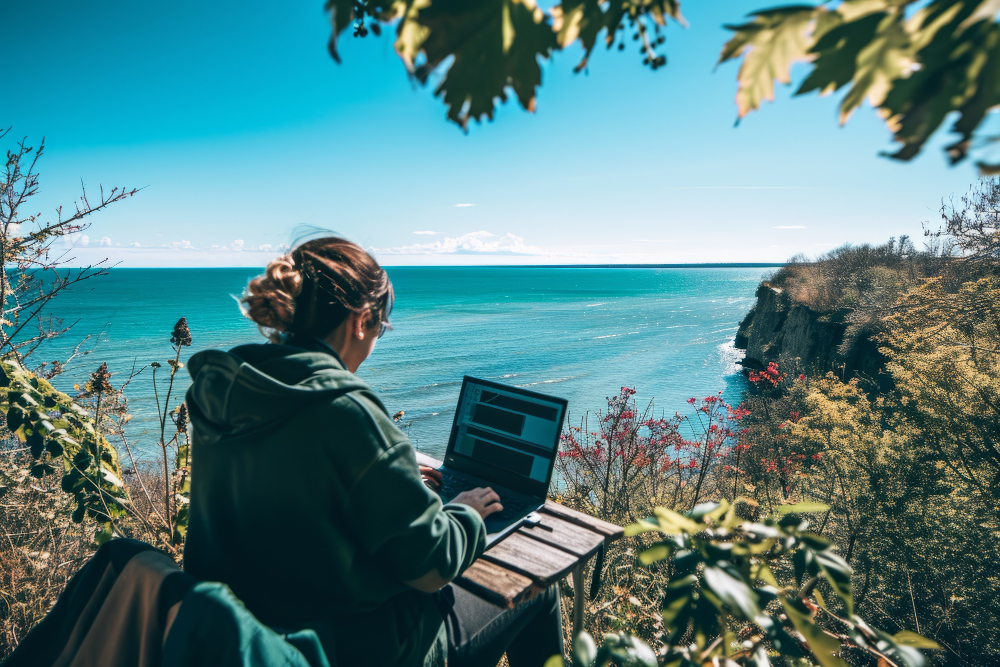From Office to Ocean View: Inside the Workcation Boom
From beaches to boardrooms, workcations redefine how Americans balance productivity, travel, and well-being.
Zoom Calls by the Sea: The Workcation Revolution
Working with an ocean view is no longer a distant dream for many Americans.
The phenomenon of workcations—work + vacation—has exploded among professionals from different fields across the Americas.

More than a passing trend, the workcation boom reflects a deep transformation in how Americans view productivity, rest, and the balance between personal and professional life.
The Birth of the Workcation Era
The COVID-19 pandemic was the major turning point. With offices closed, millions of workers began performing their duties from anywhere.
As restrictions started to lift, the idea of combining the useful with the enjoyable emerged: keeping remote work but in inspiring settings.
Cities like Miami, San Diego, Honolulu, and Austin became natural hubs for this new lifestyle.
But international destinations also grew rapidly, especially Mexico, Costa Rica, Portugal, and the Caribbean.
Who Are the New Hybrid Travelers?
Most workcation enthusiasts are professionals in technology, marketing, design, and finance—sectors that have already consolidated remote models.
The predominant age group is 28 to 45 years old, with an average annual income above US$80,000.
These travelers value flexibility, authenticity, and mental well-being. They don’t just seek a comfortable hotel but a routine that combines productivity with local experiences.
A Deloitte study showed that 68% of remote professionals in the U.S. say they feel more creative and engaged when they change their environment.
The Role of Hotels and Destinations
Hotels, resorts, and even small guesthouses have realized that offering a beautiful view is not enough—it’s essential to provide corporate-grade infrastructure for this new traveler profile.
Chains like Marriott, Hyatt, and Hilton have created specific programs, such as Work from Anywhere by Marriott Bonvoy, which combines long-stay rates, private offices, and coworking areas within resorts.
In addition, many tourist destinations are repositioning their messaging to attract hybrid travelers.
Barbados, for example, launched the 12-Month Welcome Stamp, a special visa that allows remote workers to live in the country for up to a year.
The Challenges of Mixing Work and Vacation
Maintaining discipline outside a traditional work environment requires self-management and clear boundaries.
Many professionals report difficulty in “switching ”off”—after all, when the office is the same place where you sunbathe or order a drink by the pool, the line between leisure and productivity becomes blurred.
The cost of living is also a factor, especially when moving from a cheaper location to a more expensive tourist destination in a short period.
Flights, meals, and long-term accommodations can easily consume a significant portion of one’s income.
Companies Between Control and Freedom
If, at first, workcations were an individual initiative, today many U.S. companies are officially embracing the concept.
Startups and even large corporations are now allowing—and in some cases encouraging—their employees to work from other countries for limited periods.
Salesforce, for example, launched the “Work from Anywhere Weeks” program, allowing employees to choose temporary work destinations twice a year. Shopify even offers an annual stipend to help employees cover the costs of remote work trips.
On the other hand, some companies still resist. Giants like Tesla, Amazon, and JPMorgan have returned to requiring partial or full in-office presence, citing decreased productivity and challenges in team cohesion.
Workcation as a Symbol of a New Lifestyle
More than just a travel trend, workcations represent a new cultural paradigm.
Work is no longer a fixed place—it has become a mobile experience, shaped by each professional’s personal choices.
This transformation affects not only tourism but also real estate, digital consumption, and local economies in dozens of destinations now thriving on the presence of digital nomads.
Cities like Lisbon, Medellín, Playa del Carmen, and Chiang Mai have already become true hubs for Americans seeking quality of life, pleasant weather, and lower costs.
In these places, cafés, coworking spaces, and gyms have adjusted their hours and services to cater to this new audience.
The Future of Workcation
The workcation movement is expected to consolidate in the coming years, driven by a generation that values time, freedom, and purpose as much as salary.
Between Zoom meetings and late-afternoon swims, the workcation has become more than just a way to work—it’s a new way to live.




